The global AI demand forecasting software market is projected to grow from USD 827.7 million in 2025 to USD 2,070.1 million by 2035, recording an absolute increase of USD 1,242.4 million over the period. This growth translates into a CAGR of 9.6%, underscoring the critical role artificial intelligence will play in transforming demand planning, supply chain optimization, and predictive analytics across industries. The decade ahead is expected to redefine how retailers, manufacturers, and logistics operators respond to uncertainty, consumer preferences, and global disruptions, as AI-driven forecasting systems become indispensable to modern enterprise strategies. Adoption is set to accelerate as companies seek predictive accuracy, operational agility, and resilience against volatile market conditions.
During the first half of the forecast horizon, from 2025 to 2030, the AI demand forecasting software market is projected to expand from USD 827.7 million to USD 1,194.3 million, adding USD 366.6 million in incremental value, which equates to 40% of the overall increase. This phase will be defined by a surge in digital transformation initiatives across enterprises, where machine learning models and AI-powered algorithms will be adopted to improve accuracy in demand prediction. Businesses are expected to shift from traditional statistical forecasting to advanced systems capable of analyzing real-time data inputs such as sales transactions, seasonal trends, promotions, and external economic signals. The integration of natural language processing, advanced analytics dashboards, and automated model recalibration will become standard features. What was once considered a premium capability will evolve into baseline expectations, pushing vendors to continuously innovate in terms of speed, accuracy, and scalability.
The latter half of the period, between 2030 and 2035, will contribute more significantly to overall growth, adding USD 875.8 million and accounting for 60% of the total market expansion. By 2035, the AI demand forecasting software market is projected to reach USD 2,070.1 million, as adoption moves from early innovators and large enterprises to mainstream organizations across retail, e-commerce, manufacturing, and logistics. This stage will be characterized by mass market penetration of AI-enabled forecasting engines integrated with broader enterprise resource planning (ERP) and supply chain management (SCM) ecosystems. Enterprises will prioritize solutions that ensure seamless compatibility with existing infrastructure while delivering predictive insights that enhance procurement, inventory planning, and distribution efficiency. Cloud-based deployments and hybrid models are expected to dominate, supported by growing interest in edge-based forecasting to enable real-time insights closer to operations.
The trajectory of the AI demand forecasting software industry highlights a structural shift in business practices. From 2025 to 2030, growth will be driven by the adoption of core predictive models, while from 2030 to 2035, it will be marked by widespread integration into enterprise systems and industry-wide reliance on AI-driven analytics.
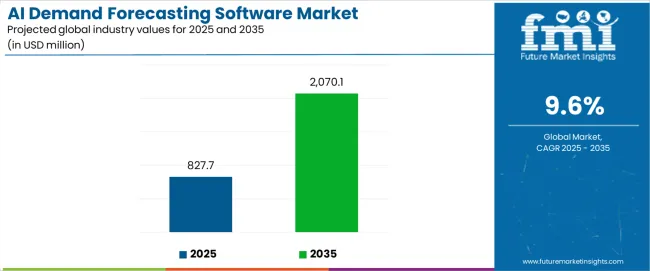
| Period | Primary Revenue Buckets | Share | Notes |
|---|---|---|---|
| Today | Cloud-based solutions (SaaS platforms, API integrations) | 66% | Scalable deployment, subscription models |
| On-premises installations | 34% | Legacy systems, security requirements | |
| Large enterprise applications | 57% | Complex supply chains, high-volume data | |
| SME implementations | 43% | Growing segment, simplified solutions | |
| Future (3-5 yrs) | Advanced cloud AI platforms | 72-75% | Multi-tenant architecture, real-time processing |
| Hybrid deployment models | 15-18% | Edge computing, data residency compliance | |
| On-premises specialized systems | 7-13% | High-security environments, custom implementations | |
| Large enterprise solutions | 52-55% | Advanced analytics, integrated platforms | |
| Mid-market applications | 28-32% | Industry-specific solutions, vertical focus | |
| SME and startup tools | 13-18% | Affordable pricing, simplified interfaces | |
| Industry-specific modules | 8-12% | Retail, manufacturing, healthcare verticals |
At-a-Glance Metrics
| Metric | Value |
|---|---|
| Market Value (2025) | USD 827.7 million |
| Market Forecast (2035) | USD 2,070.1 million |
| Growth Rate | 9.6% CAGR |
| Leading Deployment | Cloud-based Solutions |
| Primary Application | Large Enterprise Segment |
The AI demand forecasting software market demonstrates strong fundamentals with cloud-based deployment systems capturing a dominant share through advanced scalability properties and enterprise application optimization. Large enterprise applications drive primary demand, supported by increasing digital transformation requirements and supply chain management modernization initiatives. Geographic expansion remains concentrated in developed markets with established technology infrastructure, while emerging economies show accelerating adoption rates driven by manufacturing industry modernization initiatives and rising predictive analytics standards.
Primary Classification: The market segments by deployment type into cloud-based and on-premises, representing the evolution from traditional installed software to sophisticated cloud-native platforms for comprehensive demand forecasting optimization.
Secondary Classification: Application segmentation divides the AI demand forecasting software market into large enterprises and SMEs, reflecting distinct requirements for forecasting complexity, data processing capabilities, and implementation specifications.
Tertiary Classification: End-use segmentation covers retail chains, manufacturing companies, logistics providers, e-commerce platforms, and distribution centers, while deployment channels span direct sales, system integrators, and specialized technology consultants.
Quaternary Classification: Industry vertical segmentation includes retail & e-commerce, manufacturing & production, logistics & transportation, healthcare & pharmaceuticals, and consumer goods, while solution types span demand planning, inventory optimization, sales forecasting, and supply chain analytics.
Regional Classification: Geographic distribution covers North America, Latin America, Western Europe, Eastern Europe, East Asia, South Asia Pacific, and Middle East & Africa, with developed markets leading adoption while emerging economies show accelerating growth patterns driven by digital transformation programs.
The segmentation structure reveals deployment progression from traditional on-premises installations toward sophisticated cloud-based platforms with enhanced scalability capabilities, while application diversity spans from large enterprises to SMEs requiring precision forecasting solutions.
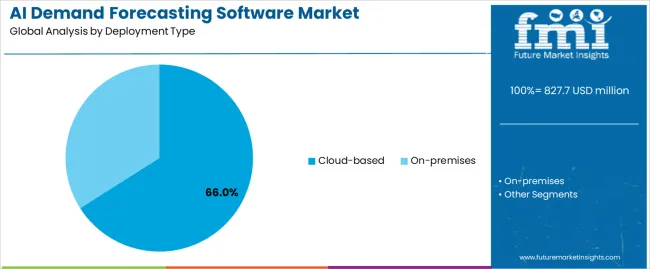
Market Position: Cloud-based deployment systems command the leading position in the AI demand forecasting software market with 66% market share through proven scalability technologies, including multi-tenant architecture, real-time processing capabilities, and enterprise integration optimization that enable businesses to achieve optimal forecasting accuracy across diverse retail and manufacturing environments.
Value Drivers: The segment benefits from enterprise preference for scalable deployment systems that provide cost-effective implementation, automatic updates, and operational flexibility without requiring on-premises infrastructure. Advanced cloud processing features enable enhanced data integration, real-time analytics, and integration with existing enterprise systems, where performance scalability and cost efficiency represent critical operational requirements.
Competitive Advantages: Cloud-based deployment systems differentiate through proven scalability reliability, cost-effective operation characteristics, and integration with established enterprise platforms that enhance business effectiveness while maintaining optimal forecasting accuracy suitable for diverse industry applications.
Key market characteristics:
On-premises deployment systems maintain a 34% market position in the AI demand forecasting software market due to their security advantages and data control positioning benefits. These solutions appeal to organizations requiring high-security implementations with enhanced data governance profiles for sensitive operations. Market growth is driven by regulated industry expansion, emphasizing security-focused solutions and operational control through optimized compliance designs.
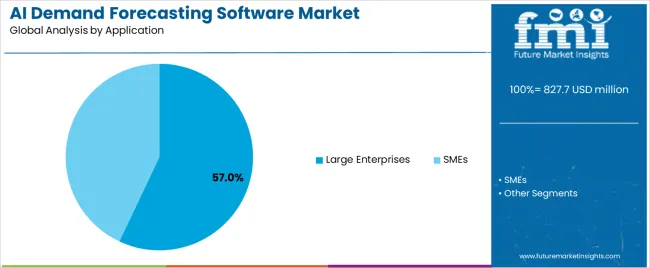
Market Context: Large enterprise applications demonstrate strong growth in the AI demand forecasting software market with 8.7% CAGR due to widespread adoption of advanced forecasting systems and increasing focus on supply chain optimization, operational cost efficiency, and predictive analytics applications that maximize forecasting effectiveness while maintaining enterprise standards.
Appeal Factors: Large enterprises prioritize forecasting accuracy, system reliability, and integration with existing enterprise infrastructure that enables coordinated demand planning operations across multiple business units. The segment benefits from substantial digital transformation investment and modernization programs that emphasize the acquisition of advanced forecasting capabilities for competitive differentiation and operational efficiency applications.
Growth Drivers: Enterprise expansion programs incorporate AI forecasting as essential components for supply chain operations, while digital transformation initiatives increase demand for forecasting capabilities that comply with enterprise standards and minimize operational complexity.
Market Challenges: Varying integration requirements and organizational complexity may limit forecasting standardization across different departments or business scenarios.
Application dynamics include:
SME applications capture 43% market share through simplified implementation requirements in small and medium enterprises, startup companies, and growing businesses. These organizations demand affordable solutions capable of supporting basic forecasting requirements while providing accuracy enhancement access and operational efficiency capabilities.
Market Context: Retail Chains dominate the AI demand forecasting software market with 8.9% CAGR, reflecting the primary demand source for AI demand forecasting technology in inventory management applications and sales optimization.
Business Model Advantages: Retail Chains provide direct market demand for standardized forecasting systems, driving volume adoption and cost optimization while maintaining accuracy control and operational consistency requirements.
Operational Benefits: Retail Chain applications include inventory optimization, demand planning, and sales forecasting that drive consistent demand for AI systems while providing access to latest machine learning technologies.
Manufacturing companies account for 35% market share, including production facilities, industrial operations, and supply chain optimization requiring advanced forecasting capabilities for efficiency optimization and operational effectiveness.
E-commerce platforms maintain 22% market share through specialized demand prediction requirements in online retail, digital marketplaces, and customer behavior analytics requiring real-time forecasting capabilities for competitive advantage and operational optimization.
| Category | Factor | Impact | Why It Matters |
|---|---|---|---|
| Driver | Digital transformation acceleration & supply chain modernization (automation trends, data analytics adoption) | ★★★★★ | Growing enterprise market requires intelligent forecasting systems with enhanced accuracy capabilities and predictive properties proven effective across business applications. |
| Driver | Inventory optimization pressure & cost reduction requirements (operational efficiency, competitive advantage) | ★★★★★ | Transforms forecasting requirements from "basic planning" to "intelligent optimization"; organizations that offer accurate forecasting and efficiency features gain competitive advantage. |
| Driver | E-commerce growth & omnichannel retail expansion (online sales, customer analytics) | ★★★★☆ | E-commerce retailers need sophisticated, real-time forecasting systems; demand for dynamic and responsive forecasting solutions expanding addressable market. |
| Restraint | Implementation complexity & integration challenges (especially for legacy systems) | ★★★★☆ | Smaller organizations defer AI adoption; increases implementation difficulty and slows advanced forecasting adoption in traditional markets. |
| Restraint | Data quality concerns & algorithm transparency issues (black box algorithms, explainable AI requirements) | ★★★☆☆ | Traditional forecasting methods offer established processes and transparency, potentially limiting AI adoption in conservative organizations. |
| Trend | Machine learning advancement & algorithm sophistication (deep learning, neural networks) | ★★★★★ | Advanced ML algorithms, accuracy optimization, and predictive analytics transform operations; algorithm advancement and performance enhancement become core value propositions. |
| Trend | Real-time processing & edge computing integration (IoT connectivity, instant analytics) | ★★★★☆ | Real-time forecasting for dynamic markets and applications; specialized processing and immediate response capabilities drive competition toward real-time solutions. |
The AI demand forecasting software market demonstrates varied regional dynamics with Growth Leaders including China (13% growth rate) and India (12% growth rate) driving expansion through digital transformation initiatives and manufacturing industry modernization. Steady Performers encompass Germany (11% growth rate), Brazil (10.1% growth rate), and developed regions, benefiting from established technology industries and enterprise software adoption. Mature Markets feature United States (9.1% growth rate), United Kingdom (8.2% growth rate), and Japan (7.2% growth rate), where enterprise advancement and digital optimization requirements support consistent growth patterns.
Regional synthesis reveals Asian markets leading adoption through manufacturing expansion and digital transformation development, while North American countries maintain steady expansion supported by AI technology advancement and enterprise optimization requirements. European markets show strong growth driven by industrial applications and efficiency integration trends.
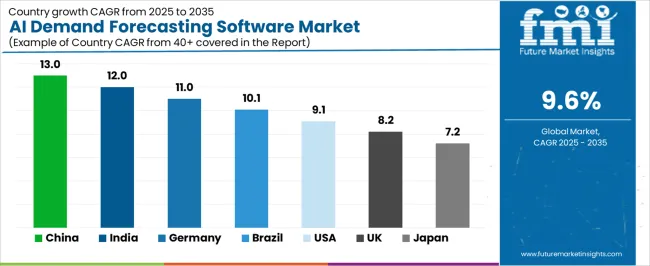
| Region/Country | 2025-2035 Growth | How to win | What to watch out |
|---|---|---|---|
| China | 13% | Focus on manufacturing integration solutions | Regulatory changes; data localization requirements |
| India | 12% | Lead with cost-effective cloud platforms | Infrastructure limitations; skilled talent shortage |
| Germany | 11% | Provide enterprise-grade industrial solutions | Over-regulation; lengthy enterprise sales cycles |
| Brazil | 10.1% | Offer scalable mid-market solutions | Currency fluctuations; economic instability |
| United States | 9.1% | Push advanced AI capabilities | Competition intensity; market saturation |
| United Kingdom | 8.2% | Focus on financial services applications | Economic uncertainty; Brexit impacts |
| Japan | 7.2% | Emphasize precision manufacturing | Traditional preferences; slow adoption rates |
China establishes fastest market growth through aggressive manufacturing digitization programs and comprehensive supply chain optimization expansion, integrating advanced AI forecasting systems as standard components in industrial facilities and retail operations. The country's 13% growth rate reflects government initiatives promoting digital transformation infrastructure and domestic AI capabilities that mandate the use of intelligent forecasting systems in manufacturing and retail facilities. Growth concentrates in major industrial hubs, including Beijing, Shanghai, and Shenzhen, where digital transformation showcases integrated AI systems that appeal to manufacturers seeking operational optimization capabilities and predictive analytics applications.
Chinese technology companies are developing cost-effective AI solutions that combine domestic innovation advantages with advanced machine learning features, including enhanced accuracy control and improved scalability capabilities. Distribution channels through system integrators and technology consultants expand market access, while government support for AI development supports adoption across diverse manufacturing and retail segments.
Strategic Market Indicators:
In Mumbai, Bangalore, and Delhi, manufacturing facilities and retail operators are implementing AI demand forecasting systems as standard equipment for inventory optimization and operational efficiency applications, driven by increasing government digitization investment and manufacturing modernization programs that emphasize the importance of predictive analytics capabilities. The AI demand forecasting software market holds a 12% growth rate, supported by government digital transformation initiatives and manufacturing development programs that promote intelligent forecasting systems for industrial and retail facilities. Indian operators are adopting AI systems that provide consistent operational efficiency and accuracy features, particularly appealing in urban regions where inventory optimization and cost effectiveness represent critical business requirements.
Market expansion benefits from growing technology capabilities and international partnerships that enable domestic development of AI forecasting systems for manufacturing and retail applications. Technology adoption follows patterns established in enterprise software, where cost-effectiveness and scalability drive procurement decisions and operational deployment.
Market Intelligence Brief:
Germany's advanced industrial market demonstrates sophisticated AI demand forecasting deployment with documented efficiency effectiveness in manufacturing applications and enterprise facilities through integration with existing industrial systems and operational infrastructure. The country leverages engineering expertise in automation and quality systems integration to maintain an 11% growth rate. Industrial centers, including Bavaria, North Rhine-Westphalia, and Baden-Württemberg, showcase premium installations where AI systems integrate with comprehensive manufacturing platforms and facility management systems to optimize operational efficiency and predictive accuracy.
German manufacturers prioritize system quality and EU compliance in AI development, creating demand for premium systems with advanced features, including industrial integration and operational optimization systems. The AI demand forecasting software market benefits from established industrial infrastructure and a willingness to invest in AI technologies that provide long-term operational benefits and compliance with international manufacturing standards.
Market Intelligence Brief:
Brazil's market expansion benefits from diverse industrial demand, including manufacturing modernization in São Paulo and Rio de Janeiro, retail facility upgrades, and government digitization programs that increasingly incorporate AI forecasting solutions for operational applications. The country maintains a 10.1% growth rate, driven by rising manufacturing activity and increasing recognition of AI forecasting benefits, including precise demand prediction control and enhanced operational effectiveness.
Market dynamics focus on cost-effective AI solutions that balance predictive accuracy performance with affordability considerations important to Brazilian enterprises. Growing industrialization creates continued demand for modern forecasting systems in new manufacturing infrastructure and facility modernization projects.
Strategic Market Considerations:
United States establishes market leadership through comprehensive enterprise programs and advanced technology infrastructure development, integrating AI demand forecasting systems across manufacturing and retail applications. The country's 9.1% growth rate reflects established technology industry relationships and mature AI adoption that supports widespread use of intelligent forecasting systems in enterprise and retail facilities. Growth concentrates in major technology centers, including California, New York, and Texas, where AI technology showcases mature deployment that appeals to enterprises seeking proven accuracy capabilities and operational efficiency applications.
American technology providers leverage established distribution networks and comprehensive technical support capabilities, including implementation programs and training support that create customer relationships and operational advantages. The AI demand forecasting software market benefits from mature regulatory standards and enterprise requirements that support AI system adoption while encouraging technology advancement and operational optimization.
Market Intelligence Brief:
United Kingdom's enterprise market demonstrates integrated AI demand forecasting deployment with documented efficiency effectiveness in retail applications and corporate facilities through integration with existing enterprise systems and operational infrastructure. The country maintains an 8.2% growth rate, supported by digital transformation programs and efficiency requirements that promote AI forecasting systems for enterprise applications. Corporate facilities across England, Scotland, and Wales showcase systematic installations where AI systems integrate with comprehensive enterprise platforms to optimize operational efficiency and predictive outcomes.
UK enterprises prioritize system reliability and industry compatibility in AI procurement, creating demand for validated systems with proven accuracy features, including performance monitoring integration and operational optimization systems. The AI demand forecasting software market benefits from established enterprise infrastructure and efficiency requirements that support AI technology adoption and operational effectiveness.
Market Intelligence Brief:
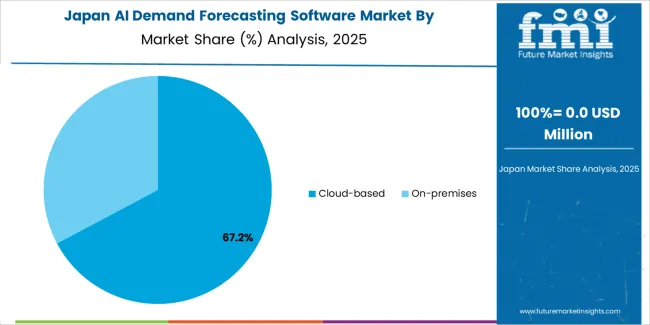
Japan's market growth benefits from precision manufacturing demand, including advanced industrial facilities in Tokyo and Osaka, quality integration, and efficiency enhancement programs that increasingly incorporate AI solutions for operational applications. The country maintains a 7.2% growth rate, driven by manufacturing technology advancement and increasing recognition of precision forecasting benefits, including accurate demand prediction control and enhanced operational outcomes.
Market dynamics focus on high-precision AI solutions that meet Japanese quality standards and operational effectiveness requirements important to manufacturing operators. Advanced industrial technology adoption creates continued demand for sophisticated forecasting systems in manufacturing facility infrastructure and operational modernization projects.
Strategic Market Considerations:
The European AI demand forecasting software market is projected to grow from USD 183.6 million in 2025 to USD 421.8 million by 2035, registering a CAGR of 8.7% over the forecast period. Germany is expected to maintain its leadership position with a 42.3% market share in 2025, supported by its advanced industrial infrastructure and major manufacturing centers.
United Kingdom follows with a 26.8% share in 2025, driven by comprehensive enterprise programs and digital transformation development initiatives. France holds a 16.4% share through specialized industrial applications and manufacturing compliance requirements. Italy commands an 8.7% share, while Spain accounts for 3.9% in 2025. The rest of Europe region is anticipated to gain momentum, expanding its collective share from 1.9% to 2.4% by 2035, attributed to increasing technology adoption in Nordic countries and emerging industrial facilities implementing digitization modernization programs.
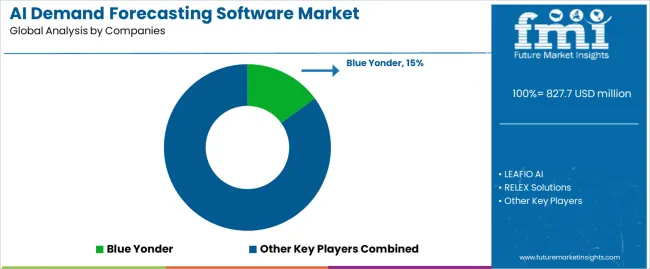
| Stakeholder | What they actually control | Typical strengths | Typical blind spots |
|---|---|---|---|
| Global platforms | Technology infrastructure, broad solution portfolios, brand recognition | Wide market reach, proven algorithms, multi-industry support | Innovation cycles; customer dependency on platform lock-in |
| ai specialists | Algorithm R&D; advanced machine learning technologies; enhanced accuracy capabilities | Latest AI technologies first; attractive ROI on prediction effectiveness | Market penetration outside core segments; scaling complexity |
| Industry experts | Vertical knowledge, specialized implementations, domain expertise | "Deep industry" understanding; pragmatic solutions; sector regulations | Technology gaps; talent retention in specialized areas |
| Enterprise vendors | Platform integration, implementation services, enterprise connectivity | Lowest operational risk; comprehensive enterprise support | Service costs if overpromised; technology obsolescence |
| Niche innovators | Specialized algorithms, custom solutions, vertical applications | Win premium implementations; flexible configurations | Scalability limitations; narrow market focus |
| Item | Value |
|---|---|
| Quantitative Units | USD 827.7 million |
| Deployment Type | Cloud-based, On-premises |
| Application | Large Enterprises, SMEs |
| End Use | Retail Chains, Manufacturing Companies, E-commerce Platforms, Logistics Providers, Distribution Centers |
| Industry Vertical | Retail & E-commerce, Manufacturing & Production, Logistics & Transportation, Healthcare & Pharmaceuticals, Consumer Goods |
| Solution Type | Demand Planning, Inventory Optimization, Sales Forecasting, Supply Chain Analytics |
| Regions Covered | North America, Latin America, Western Europe, Eastern Europe, East Asia, South Asia Pacific, Middle East & Africa |
| Countries Covered | China, India, Germany, Brazil, United States, United Kingdom, Japan, Canada, France, Australia, and 30+ additional countries |
| Key Companies Profiled | LEAFIO ai, Blue Yonder, RELEX Solutions, Kinaxis, SAS, C3 ai, Infor, Intuendi, Prediko |
| Additional Attributes | Dollar sales by deployment type and application categories, regional adoption trends across China, India, and Germany, competitive landscape with AI technology providers and enterprise software vendors, business operator preferences for forecasting accuracy and operational optimization, integration with enterprise platforms and supply chain management systems, innovations in machine learning algorithms and AI enhancement, and development of advanced forecasting solutions with enhanced accuracy and predictive optimization capabilities. |
The global AI demand forecasting software market is estimated to be valued at USD 827.7 million in 2025.
The market size for the AI demand forecasting software market is projected to reach USD 2,070.1 million by 2035.
The AI demand forecasting software market is expected to grow at a 9.6% CAGR between 2025 and 2035.
The key product types in AI demand forecasting software market are cloud-based and on-premises.
In terms of application, large enterprises segment to command 57.0% share in the AI demand forecasting software market in 2025.






Full Research Suite comprises of:
Market outlook & trends analysis
Interviews & case studies
Strategic recommendations
Vendor profiles & capabilities analysis
5-year forecasts
8 regions and 60+ country-level data splits
Market segment data splits
12 months of continuous data updates
DELIVERED AS:
PDF EXCEL ONLINE
Airless Sprayer Accessories Market Size and Share Forecast Outlook 2025 to 2035
Air Purge Valve Market Size and Share Forecast Outlook 2025 to 2035
AI Image Editor Market Size and Share Forecast Outlook 2025 to 2035
Air Flow Sensors Market Size and Share Forecast Outlook 2025 to 2035
Air Separation Plant Market Size and Share Forecast Outlook 2025 to 2035
Air Cooled Turbo Generators Market Size and Share Forecast Outlook 2025 to 2035
Aircraft Cooling Turbines Market Size and Share Forecast Outlook 2025 to 2035
Air Conditioning Compressor Market Size and Share Forecast Outlook 2025 to 2035
Air Measuring Equipment Market Size and Share Forecast Outlook 2025 to 2035
Aircraft Smoke Detection and Fire Extinguishing System Market Size and Share Forecast Outlook 2025 to 2035
Aircraft Hose Fittings Market Size and Share Forecast Outlook 2025 to 2035
Aircraft Cabin Interior Market Size and Share Forecast Outlook 2025 to 2035
Aircraft Galley Systems Market Size and Share Forecast Outlook 2025 to 2035
Aircraft Interior Lighting Market Size and Share Forecast Outlook 2025 to 2035
Aircraft Battery Market Size and Share Forecast Outlook 2025 to 2035
Aircraft Floor Panels Market Size and Share Forecast Outlook 2025 to 2035
Aircraft Fuel Systems Market Size and Share Forecast Outlook 2025 to 2035
Aircraft Lubricant Market Size and Share Forecast Outlook 2025 to 2035
Aircraft Seat Market Size and Share Forecast Outlook 2025 to 2035
Aircraft Ground Support Equipment Market Size and Share Forecast Outlook 2025 to 2035

Thank you!
You will receive an email from our Business Development Manager. Please be sure to check your SPAM/JUNK folder too.
Chat With
MaRIA